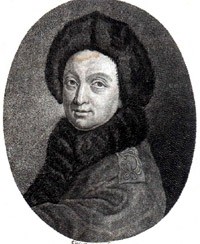| Profile | Major Works | Resources |
Pierre Louis Moreau de Maupertuis, 1698-1759.

The "French Newton", Maupertuis was one of France's foremost astronomers, physicists, geographers, biologists and mathematicians of the Enlightenment period.
Originally a soldier, Maupertuis became acquainted with the work of Sir Isaac Newton during a journey to England in 1728. It was Maupertuis who was responsible for bringing Newton's work to a wider audience on the Continent (esp. with his 1732 work) and thereby making him the poster boy of the Enlightenment spirit. He was the tutor of Madame du Châtelet (the translator of Newton's Principia and Voltaire's mistress). In 1736-7, Maupertuis led a famous expedition to Lapland to measure the degree of the meridien and thereby proving the Newtonian conjecture about the flattening of the globe at the poles.
In 1745, he was invited by Frederick of Prussia to head the royal academy of sciences in Berlin. His activities there attracted numerous scholars and scientists, making Berlin one of the poles of the Enlightenment age. In 1744, Maupertuis provided a new formulation of Fermat's "principle of least action", which was later taken up by Euler, Lagrange and Hamilton (it also led to a protracted controversy with Samuel König). Maupertuis's 1745 work promulgates an early version of the theory of evolution and his 1751 work on hereditary traits presages the modern notion of dominant and recessive genes. Jealous of his prominence in Prussian society, Voltaire's acerbic wit (esp. Diatribe du Docteur Akakia and Micromégas) made life in Berlin quite uncomfortable for Maupertuis . Maupertuis's 1768 works on linguistics were critically reviewed by Jacques Turgot.
Maupertuis's presence on this website is mainly due to his philosophy of "negative hedonism" (1749). Like Locke and Maupertuis conceived of the pleasure/pain calculus in an asymmetric manner: pleasure was merely "tranquility", while pain -- or more precisely, "uneasiness" -- is the generator of action (to remove pain, etc.). Thus, in Maupertuis's conception, human behavior is not characterized as the pursuit of pleasure, but merely pain-avoidance. A deep pessimism about the possibility of achieving happiness, Maupertuis recommends a Stoical rather than an Epicurean outlook to life, as the former will minimize uneasiness, whereas the desire for happiness will just create more uneasiness. Maupertuis's negative hedonism was taken up by the Italian utilitarians, such as Genovesi, Ortes, Verri and Beccaria.
|
Major Works of Pierre Moreau de Maupertuis
|
|
HET
|
|
Resources on P.M. de Maupertuis
|
All rights reserved, Gonçalo L. Fonseca
